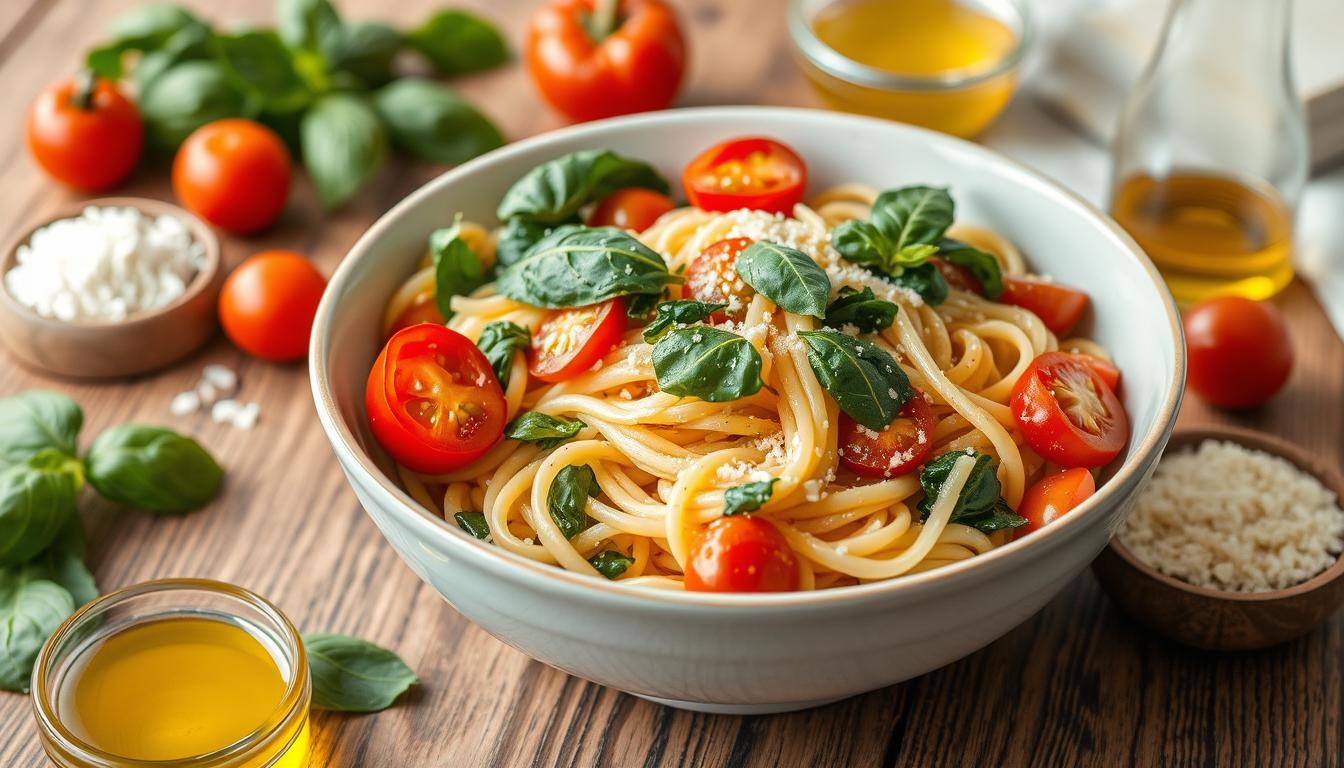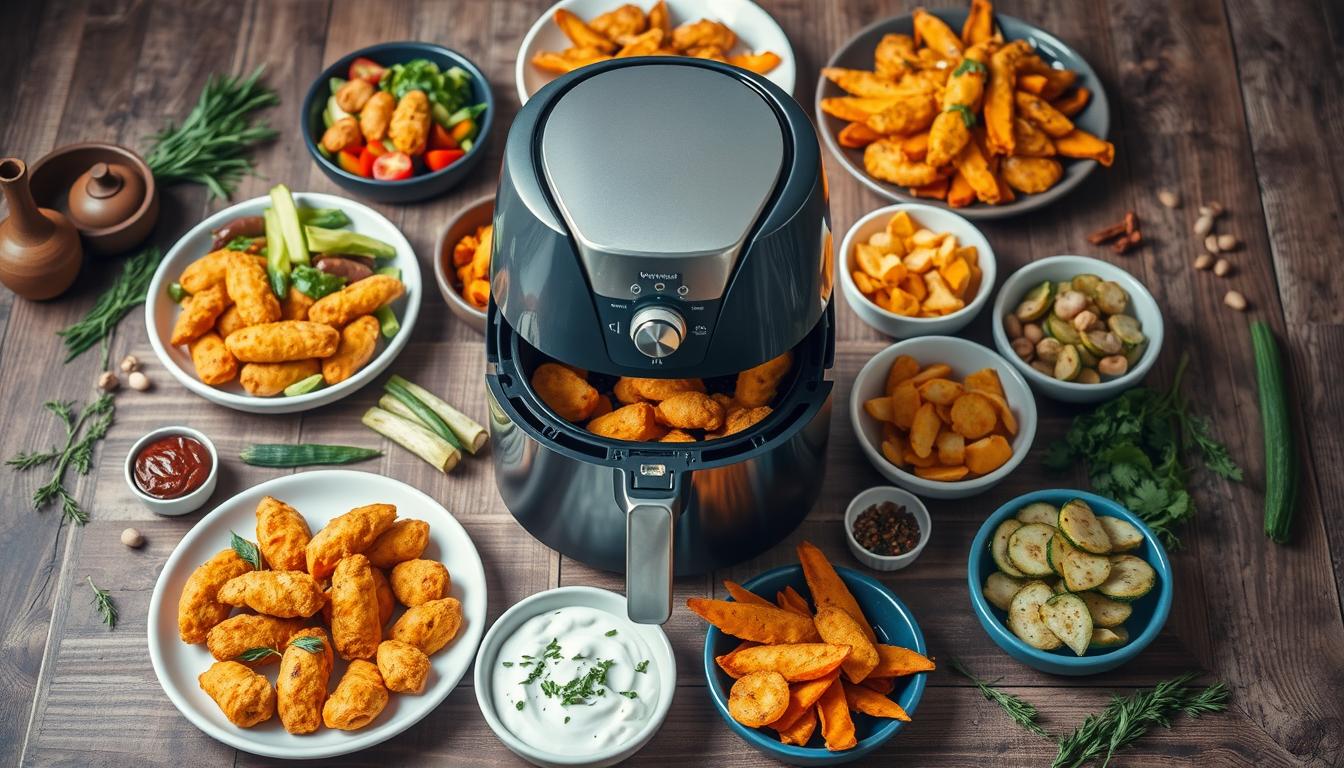Persian cuisine has a long history, over three thousand years old. It has influenced areas from Greece to Egypt and more. This cuisine is famous for balancing warm and cool flavors, a key part of making authentic Persian recipes.
The core of Persian cooking is not just about taste. It also uses common ingredients like dried limes, saffron, and pomegranate molasses. As you dive into this rich culinary world, you’ll learn to make Persian dishes that excite your taste buds and fill your home with amazing smells.
Join us as we explore the deep meaning of food in Persian culture. We’ll discover the iconic dishes that truly show off the authentic Persian flavors.
An Introduction to Persian Food
Persian food is a journey of vibrant flavors and textures. It invites you to explore authentic Persian cuisine. Each dish is a mix of spices, herbs, fruits, and meats, all balanced perfectly.
When you try Middle Eastern recipes, you’ll see how old cooking methods add to the rich flavors. This makes Persian food truly special.
Exploring the Balance of Flavors
Persian cuisine is all about mixing sweet, savory, and sour tastes. For example, pomegranate molasses adds a tangy sweetness, while saffron brings a unique aroma.
Popular dishes like barg and koobideh are known for their juicy taste and deep flavors. Desserts often include floral notes, like rose and orange blossom, for a rich taste.
Essential Ingredients in a Persian Pantry
To make authentic Persian dishes, you need the right ingredients. Must-haves include walnuts, saffron, and pomegranates.
Preparing Persian rice involves washing and soaking the rice for 30 minutes. Spices like advieh and dried fruits like barberries or sour cherries are key for flavor. Many recipes can be made in under an hour, making Persian cooking easy for any day.
| Ingredient | Purpose |
|---|---|
| Saffron | Flavor and color enhancer |
| Pomegranate Molasses | Sweet and tangy flavoring agent |
| Advieh | Signature spice blend |
| Barberries | Sour flavor in rice dishes |
| Rosewater | Floral aroma in desserts |
Understanding Garm and Sard in Persian Cooking
In Persian cooking, garm (warming) and sard (cooling) are key. They decide how foods affect your body. Traditional Iranian dishes use this balance to keep you healthy. For thousands of years, Iranians have used food to heal.
Concept of Warming and Cooling Foods
In Persian cuisine, foods are sorted into garmi and sardi. This sorting helps keep your body in balance. It’s important to avoid sickness caused by bad diets.
Mixing both warming and cooling foods is key. It brings harmony and boosts your health.
- Examples of Garm foods:
- Ghee
- White fish
- Sesame oil
- Dried fruits
- Lamb
- Cinnamon
- Ginger
- Turmeric
- Examples of Sard foods:
- Yogurt
- Cucumber
- Pomegranate
- Potatoes
- Watermelon
- Eggplant
- Rice
Mixing these foods in equal parts is important. Dishes like Steamed Saffron Rice and Khoresh Bademjan Stew show this balance. Cooking like this makes your meals healthy and follows ancient wisdom.
A Tradition of Entertaining Through Food
In Persian culture, food is more than just food. It’s a tradition of hospitality and community. When people gather to eat, it’s not just about the meal. It’s a celebration of relationships and a key part of social life.
At any Iranian dinner party, you’ll find many appetizers and dishes. These dishes are made to delight the senses. They show the best of Persian recipes.
The Role of Food in Persian Culture
Persian cuisine is deeply rooted in culture. Each dish tells a story of heritage and tradition. Nowruz, the Persian New Year, is a great example of this.
Nowruz is celebrated during the Spring Equinox. It’s a two-week festival filled with traditional recipes. These recipes are shared through gatherings and meals.
Kuku Sabzi and Sabzi Polo Baa Mahi are special dishes during Nowruz. Kuku Sabzi makes 4 servings as a main or 8 as a starter. It takes just 15 minutes to prepare and 35 minutes total. Sabzi Polo Baa Mahi requires marinating salmon for at least 30 minutes and cooking the rice over medium heat.
The focus on homemade meals is a key part of Persian dining. Iran’s national obesity rate is 22%, compared to over 40% in the United States. This shows that fresh, home-cooked meals help Iranians stay healthy.
Authentic Persian cuisine not only tastes great but also supports a healthier lifestyle. Many Iranian immigrants keep their traditional food practices even in America.
In gatherings, dishes are presented as art. They show the colorful and intricate nature of Persian food. Ingredients like barberries and sumac add to the flavors, making meals memorable.
Every meal is a chance to show love and warmth. It highlights the important role food plays in Persian culture. It’s about bonding and keeping relationships strong.
Persian Recipes: Iconic Dishes You Must Try
Exploring the best Persian food, you’ll find dishes that stand out. They are known for their flavors and cultural importance. Traditional Persian cuisine offers a variety of delicious options, especially stews and rice dishes.
Persian Stews and Their Rich Flavors
Persian stews, or Khoresh, are a key part of the cuisine. They are famous for their complex flavors. Fesenjan, or Pomegranate Walnut Stew, is often served at big gatherings like weddings.
Ghormeh Sabzi is another favorite, often eaten with plain or saffron rice. Dizi, or Abgoosht, is comfort food in Iran. It’s enjoyed with bread and fresh veggies.
Famous Persian Rice Dishes
Persian rice dishes are diverse and show the heart of traditional Persian cuisine. Chelo Kabab, with its saffron-infused rice, is a beloved dish. Tahchin, a baked rice dish with yogurt and saffron, is called “Iranian cake” for its elegant look.
Baghali Polo, with dill and fava beans, is a luxurious rice dish found in upscale restaurants.
Persian cuisine’s rich traditions blend flavors influenced by the country’s geography and culture. The variety of rice and stew preparations adds to the rich flavors of Persian food.
| Dishes | Main Ingredients | Special Characteristics |
|---|---|---|
| Fesenjan | Poultry, walnuts, pomegranate molasses | Commonly served at important gatherings |
| Ghormeh Sabzi | Herbs, kidney beans, lamb | Favorite dish among Iranians, widely enjoyed |
| Chelo Kabab | Marinated meat, saffron rice | The most famous dish in Iran |
| Tahchin | Rice, yogurt, saffron, chicken | Known as “Iranian cake” for its elegance |
| Baghali Polo | Rice, fava beans, dill | Considered an expensive meal in restaurants |
Persian cuisine is a journey of aromatic rice dishes and hearty stews. It captures the spirit of a culture rich with history and tradition. Every meal is a story, inviting you to explore the flavors of Persian food.
Exploring Popular Persian Recipes
Start your journey in Persian cooking with some of the most loved dishes. Whether you want simple recipes at home or a grand feast, learning about these meals adds to your experience.
The Most Requested Dishes in Persian Cuisine
Everyday favorites include Khoresht Bademjoumn, a spiced beef stew, and rice pilaf. Rice is more than a food; it’s a sign of welcome in Persian culture. Meals are fresh, with herbs, grilled meats, and citrus, adding to the flavor.
Tahdig, or crispy rice, is a sign of a cook’s skill and pride. It’s seen as an art that makes any meal special. Family meals share bread, yogurt, salads, and rice, making dining warm and communal.
Celebrated Occasions and Their Signature Dishes
At big events like weddings or Nowruz, special dishes are served. Kuku Sabzi, a herb-filled frittata, and Jujeh Kabob, marinated chicken skewers, are favorites. The effort put into making rice just right shows the commitment to quality.
For your celebrations, try a colorful platter of fresh herbs with cheese or a simple cucumber and yogurt salad. These pair well with richer dishes.
Easy Persian Cooking: Quick Recipe Ideas
You don’t need to be a pro in the kitchen to make delicious Persian meals. This section offers quick Persian recipe ideas for weeknight dinners and gatherings. You can enjoy traditional Iranian dishes without spending hours cooking.
Simple Weeknight Meals
For quick meals, try making Persian salads or kabobs. Dishes like Ghormeh Sabzi and Fesenjān are great for dinner. They serve four and are loved for their rich flavors and ingredients like lamb or chicken.
Prep times vary from 10 minutes to longer, depending on the ingredients.
Speedy Snacks for Entertaining
Impress your guests with quick, tasty snacks. Try making Kashke Bademjan (Persian Eggplant Dip) or Mast o Khiar (Cucumber Yogurt Dip). These snacks are easy to make and take about 30 minutes to an hour.
Many people love these appetizers, like the Persian Appetizer Platter and Sabzi Khordan.
Classic Persian Kabob Dishes
Kabobs are a big deal in Persian food, loved for their tasty meats and bright flavors. Kabob Koobideh is a top pick, made with lamb and beef, onions, and spices. It’s not just tasty but also quick to make.
Different Types of Kabobs and Their Preparation
Persian cuisine has many kabob types, each with its own way of making. Kabob Koobideh, a mix of ground beef, onions, cilantro, salt, and spices, is ready in under 30 minutes. It needs just 10 minutes to prepare and cook.
It’s important to chill the meat mix for at least an hour for the right texture. When grilling, turn the skewers often to cook evenly.
Perfectly Marinated Meats for Juicy Flavor
Marination is key for juicy Persian dishes. For Kabob Koobideh, mix the meat with grated onions for extra moisture and flavor. Serve with fluffy Basmati rice, grilled tomatoes, and Doogh for a great meal.
Delicious Persian Meals for Every Occasion
Persian cuisine offers a wide range of delicious meals for any event. Whether it’s a big family gathering or a quiet dinner, Persian dishes have something for everyone. Their variety and flavors are sure to please any palate.
Hearty Meals for Family Gatherings
At family gatherings, big, hearty dishes are often the stars. Try Ghormeh Sabzi, a famous herb stew that captures the heart of Iranian cooking. It’s considered one of the best Iranian dishes.
For another option, Khoresh-e Rivas is a lamb and rhubarb stew loved during rhubarb season. Baghala Ghatogh is also great, with its mix of flavors and textures. It’s perfect for a cozy family meal.
Light and Flavorful Options for Weeknights
Weeknights can be busy, so it’s good to have light, easy Persian recipes. Kookoo Kadoo, a courgette frittata, is quick and comforting. Pair it with a fresh salad for a balanced meal.
For a refreshing drink, try Pomegranate Saffron Sharbat. It’s a mix of pomegranate, saffron, and lime. It’s perfect for cooling down on a busy evening.
| Dish Name | Main Ingredients | Ideal Occasion |
|---|---|---|
| Ghormeh Sabzi | Herbs, kidney beans, lamb | Family Gatherings |
| Khoresh-e Rivas | Lamb, rhubarb | Seasonal Celebrations |
| Baghala Ghatogh | Broad beans, rice | Casual Family Dinner |
| Kookoo Kadoo | Courgette, eggs | Quick Weeknight Meal |
| Pomegranate Saffron Sharbat | Pomegranate, saffron, lime | Refreshing Drink |
Try these dishes to bring warmth and flavor to your meals. They’re perfect for family gatherings or cozy dinners at home.
Traditional Iranian Dishes Worth Exploring
Iran’s food scene is rich and varied, showing the country’s long history and cultural mix. For those wanting to try real Persian food, knowing about different areas helps. It shows the unique tastes and cooking methods of this tradition.
Unique Flavors of Iranian Cuisine
Iranian food is known for its fresh herbs, like in Khoresh-e Ghormeh Sabzi. This dish mixes herbs, red kidney beans, and lamb, offering a tasty and fragrant experience. Another favorite is Khoresht-e Fesenjan, with its walnut and pomegranate molasses flavor, enjoyed at big events.
Regional Variations of Persian Dishes
Dishes vary across Iran. In the north, Baghali Polo ba Mahiche is a hit, with its rice, broad beans, and saffron, perfect for weddings. The south is known for Zereshk Polo, with barberries and rice, often with grilled chicken at family meals. From Persian flatbread to Kaymak, each region brings its own special touch to Persian food.
Decadent Persian Desserts to Indulge In
Desserts are a big deal in Persian culture. They’re known for their complex flavors and textures. You’ll find easy Persian recipes here that make your meals unforgettable.
Popular Sweets and Their Ingredients
Persian desserts celebrate sweet flavors with natural ingredients. Sholeh Zard, a saffron rice pudding, uses basmati rice, rosewater, and saffron. Baklava is loved in cities like Yazd and Tabriz for its nuts and spices. Gaz, a nougat candy, is a hit at celebrations with its rose water and pistachios.
How to Prepare Authentic Persian Desserts
Learning how to make these sweets is crucial. Baghlava is baked until golden, then soaked in a sweet syrup. It’s best to let it sit for an hour or overnight to soak up the syrup fully. Shir Berenj, or rice pudding, is another favorite, topped with pistachios for extra taste. Using sprouted wheat flour makes your recipes healthier with more fiber.
Conclusion
Traditional Persian cuisine is a world of flavors and cultural experiences. It includes dishes like Khoresht Fesenjan, made with 8 chicken thighs, 4 cups of walnuts, and pomegranate paste. These ingredients give the dish its vibrant color and taste.
Nowruz celebrations show the depth and diversity of Persian recipes. They highlight the importance of fresh vegetables, legumes, and spices. These elements make Persian meals not only delicious but also healthy, as seen in the Modern Persian Food podcast.
Persian cooking is all about balance. It aims to nourish and bring people together. This is especially true during Nowruz, a 12-day festival that celebrates the start of spring.
By cooking Persian dishes, you can create unforgettable meals for your guests. It’s more than just food; it’s a celebration of culture and heritage.
Exploring traditional Persian cuisine opens up a world of vibrant tastes and traditions. It invites you to appreciate the art of cooking Persian food. So, dive into these dishes and share their joy with your loved ones.
Are you looking for something new to bake? There’s a whole world of delicious recipes out there waiting for cooking. From classic favorites to innovative twists, there’s a recipe for every taste and occasion.
FAQ
What are some key ingredients I need for authentic Persian recipes?
For real Persian dishes, you’ll need saffron, pomegranate molasses, and Persian 7 spice (Advieh). Don’t forget dried fruits and herbs. These add unique and tasty flavors to your meals.
How do I achieve the balance of flavors in Persian cooking?
In Persian cooking, balance is key. It’s about mixing warm and cool flavors. Learning this helps make dishes that taste amazing and are good for you too.
What are some popular Persian recipes to try at a gathering?
For a gathering, try making Ghormeh Sabzi, Joojeh Kabob, or Shirin Polo. These dishes are famous for their rich tastes and beautiful looks.
Can I prepare Persian food quickly for weeknight meals?
Yes! Quick Persian recipes include simple salads, easy kabobs, and flavorful rice pilafs. They offer a true taste of Persian cuisine without taking too long.
What are some traditional Iranian dishes to explore?
Try Fesenjan, a stew with pomegranate molasses and walnuts, and Tahdig, the crispy rice. Iran’s different regions offer unique flavors in their dishes.
How important are desserts in Persian cuisine?
Desserts are very special in Persian meals. They often have delicate flavors like rose and saffron. Sweets like Baklava and Shirin Berenji are good to show hospitality and celebrate.




























